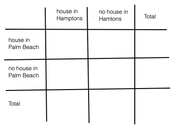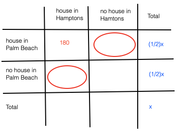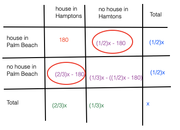At a charity fundraiser, 180 of the guests had a house both in the Hamptons and in Palm Beach. If not everyone at the fundraiser had a house in either the Hamptons or Palm Beach, what is the ratio of the number of people who had a house in Palm Beach but not in the Hamptons to the number of people who had a house in the Hamptons but not in Palm Beach?
(1) One-half of the guests had a house in Palm Beach.
(2) Two-thirds of the guests had a house in the Hamptons
OA E
Source: Manhattan Prep
At a charity fundraiser, 180 of the guests had a house both
This topic has expert replies
-
BTGmoderatorDC
- Moderator
- Posts: 7187
- Joined: Thu Sep 07, 2017 4:43 pm
- Followed by:23 members
Timer
00:00
Your Answer
A
B
C
D
E
Global Stats
GMAT/MBA Expert
- ceilidh.erickson
- GMAT Instructor
- Posts: 2095
- Joined: Tue Dec 04, 2012 3:22 pm
- Thanked: 1443 times
- Followed by:247 members
Timer
00:00
Your Answer
A
B
C
D
E
Global Stats
This is a classic OVERLAPPING SETS problem. It is usually best to set these up with a DOUBLE-SET MATRIX:

From the question stem, we know that 180 guests have houses in both locations, and we're looking for the ratio of the two circled boxes:

There's nothing else we can infer from the question stem, so we move on to statement 1:
(1) One-half of the guests had a house in Palm Beach.
From this we can also infer that half the guests do NOT have a house in Palm Beach:

This gives us no information about the two circled boxes, though. Insufficient.
Make sure that you always erase what you learned from statement 1 before tackling statement 2 in DS overlapping sets!
(2) Two-thirds of the guests had a house in the Hamptons
From this we can also infer that 1/3 of guests did NOT, but it tell us nothing about our circled boxes:

(1) and (2) together:
Intuitively, you might be able to tell that we don't have enough information to fill in our circled boxes. But if we wanted to prove it, here's what we know algebraically:

If we simplify the equation in our second row, we get:
((2/3)x + 180) + ((1/3)x - ((1/2)x - 180)) = (1/2)x
(2/3)x + 180 + (1/3)x - (1/2)x + 180 = (1/2)x
(2/3)x + (1/3)x - (1/2)x = (1/2)x
x - (1/2)x = (1/2)x
This is a tautology; we cannot solve for x. We can't infer anything about the ratios of the circled boxes.
The answer is E.

From the question stem, we know that 180 guests have houses in both locations, and we're looking for the ratio of the two circled boxes:

There's nothing else we can infer from the question stem, so we move on to statement 1:
(1) One-half of the guests had a house in Palm Beach.
From this we can also infer that half the guests do NOT have a house in Palm Beach:

This gives us no information about the two circled boxes, though. Insufficient.
Make sure that you always erase what you learned from statement 1 before tackling statement 2 in DS overlapping sets!
(2) Two-thirds of the guests had a house in the Hamptons
From this we can also infer that 1/3 of guests did NOT, but it tell us nothing about our circled boxes:

(1) and (2) together:
Intuitively, you might be able to tell that we don't have enough information to fill in our circled boxes. But if we wanted to prove it, here's what we know algebraically:

If we simplify the equation in our second row, we get:
((2/3)x + 180) + ((1/3)x - ((1/2)x - 180)) = (1/2)x
(2/3)x + 180 + (1/3)x - (1/2)x + 180 = (1/2)x
(2/3)x + (1/3)x - (1/2)x = (1/2)x
x - (1/2)x = (1/2)x
This is a tautology; we cannot solve for x. We can't infer anything about the ratios of the circled boxes.
The answer is E.
Ceilidh Erickson
EdM in Mind, Brain, and Education
Harvard Graduate School of Education
EdM in Mind, Brain, and Education
Harvard Graduate School of Education
GMAT/MBA Expert
- ceilidh.erickson
- GMAT Instructor
- Posts: 2095
- Joined: Tue Dec 04, 2012 3:22 pm
- Thanked: 1443 times
- Followed by:247 members
Timer
00:00
Your Answer
A
B
C
D
E
Global Stats
Overlapping Sets are a common question type on the GMAT, and the double-set matrix is often the easiest way to solve. For more on how to use the matrix, see:
https://www.beatthegmat.com/among-the-m ... tml#827756
https://www.beatthegmat.com/in-a-class- ... tml#802582
https://www.beatthegmat.com/jefferson-s ... tml#708717
https://www.beatthegmat.com/sandwich-t2 ... tml#730500
https://www.beatthegmat.com/ds-question ... tml#677080
https://www.beatthegmat.com/survery-res ... tml#576105
https://www.beatthegmat.com/rainbow-tro ... tml#555603
You also may notice that with overlapping sets in DS, the answer often ends up being E. That certainly doesn't mean that the answer will always be E, but E seems to be more likely to show up in this topic than in others:
https://www.beatthegmat.com/for-what-pe ... tml#818652
https://www.beatthegmat.com/in-a-produc ... tml#818274
https://www.beatthegmat.com/retailers-q ... tml#809549
https://www.beatthegmat.com/among-the-m ... tml#827756
https://www.beatthegmat.com/in-a-class- ... tml#802582
https://www.beatthegmat.com/jefferson-s ... tml#708717
https://www.beatthegmat.com/sandwich-t2 ... tml#730500
https://www.beatthegmat.com/ds-question ... tml#677080
https://www.beatthegmat.com/survery-res ... tml#576105
https://www.beatthegmat.com/rainbow-tro ... tml#555603
You also may notice that with overlapping sets in DS, the answer often ends up being E. That certainly doesn't mean that the answer will always be E, but E seems to be more likely to show up in this topic than in others:
https://www.beatthegmat.com/for-what-pe ... tml#818652
https://www.beatthegmat.com/in-a-produc ... tml#818274
https://www.beatthegmat.com/retailers-q ... tml#809549
Ceilidh Erickson
EdM in Mind, Brain, and Education
Harvard Graduate School of Education
EdM in Mind, Brain, and Education
Harvard Graduate School of Education



















